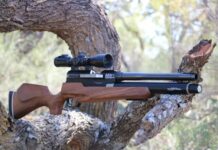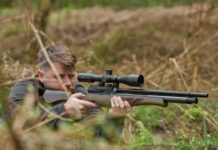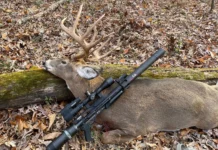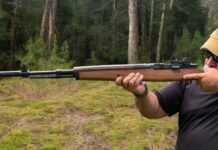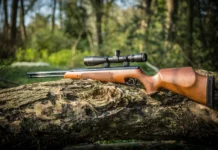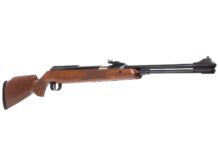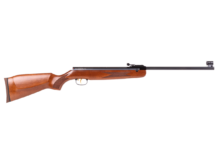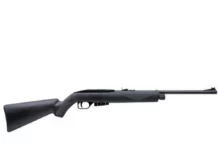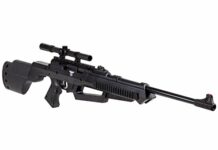Over the past five or six decades, the .308 Winchester has carved out a healthy niche as one of the best all-around medium-game centerfire cartridges in North America. The .308 uses projectiles that range anywhere from 110-grain super light varmint loads, all the way up to 180-grain and even some 190-grains.
The best part about the .308 is it carries most of the punch of a .30-06 with the same bullet, but with far less felt recoil. Oh, and did we mention it’s the original chambering of the venerable but potent AR-10? The 6.5 Creedmoor is also a short-action caliber, perfectly suited for the same actions as a .308, including a 6.5 Creedmoor AR-10 upper.
But let’s not put the cart before the horse, now. Let’s take a look at these two middleweights that always punch up.
Table of Contents
History
These two calibers may be first out of the same make and model of rifle, but their histories are quite a lot different from one another. One was designed by the Army arsenals as a combat arms cartridge (the .308), while the other was designed from the ground up as a long-range target shooting caliber.
The great irony here is that they both have become wildly popular in medium-game hunting, even though neither one was intended for hunting use in the first place! Of course, this isn’t anything new: the venerable .30-06 Springfield is the most used centerfire caliber in North America (so probably the world), and it was a main battle rifle caliber introduced in the earliest years of the 20th century. But I digress.
.308 Winchester

The .30-06 went into service with the U.S. Army in 1906, hence the name. It was the mainstay rifle during World War I in the M1903 rifle. It was then used in the M3 machine gun, and of course, the M1 Garand.
However, they wanted a case that could deliver comparable performance out of a substantially smaller case. The shorter case results in a more compact overall weapon profile (short-action versus long-action). In fact, if you think about it, issuing M1903s and M1 Garands to the average sized mail 1906-1945 is pretty amazing; the average height in the early 20th century was around 5’7”. A Garand is a huge rifle for guys that size.
The M1 carbine was much more compact and was paired up with either a 20-round or 30-round magazine which provided a lot of firepower, especially against a K-98 Mauser or a Japanese Type 99. However, the .30 carbine, a straight-walled cartridge, leaves a little to be desired in a main battle rifle.
The .308 afforded most of the knock-down power of the .30-06, most if not all of the range, in a cartridge that could operate in a smaller weapon, more compact magazines, etc.
6.5 Creedmoor

Conversely, the 6.5 Creedmoor is a dedicated long-range competition caliber that has been adopted into hunting circles as a competent and efficient long-range caliber. Since it is a comparable size to the .308, it is easily adapted to short-action rifles (Remington Model 700, Savage Model 110, Winchester Model 70 and so on).
The 6.5 bullet translates roughly to .264”, so in practical terms it is slightly smaller than a .270 Winchester. Common bullet weights are a little lighter than the .308 and align closely with .270, ranging from the blistering-fast 95-grain Hornady V-Max, to the heavy 147-grain match bullets.
It is also a youthful caliber, first introduced by Hornady in 2007, unlike the .308 which hails all the way back to the World War II-era.

Ballistics
These two calibers are compared all over the internet because of their similar case sizes which allow them to be chambered in similar firearms, and they are used in similar sized game. Perhaps the best selling point is the ability to buy a single AR-10 lower receiver and use either caliber with the swap of an upper. Of course, you get to tailor the optics for whatever is best suited for that caliber of upper. Ultimate versatility.
We are going to speak in generalities here because there are almost unlimited combinations of bullet weights and styles that could be compared.
Velocity
The Creedmoor gets the nod here, predictably, since it is generally a lighter projectile. For example, 125-grain Deer Season XP from Winchester scoots along at 2,850fps from the muzzle. Ok, so the same exact bullet in .308 exits the muzzle at 2,820fps. Not exactly earth-shattering, right?
Well, let’s take it out to 200 yards. Practically speaking, this is about as far as any whitetail hunters that I know are taking shots.
6.5 Creedmoor: 2,520fps, 1,763ft/lbs, and -3.3” drop.
.308 Winchester: 2,368fps, 1,867ft/lbs, and -3.7 drop.
Nothing crazy here.
Now take it out to 500 yards:
6.5 Creedmoor: 2,069fps, no energy reported, and -41” drop.
.308 Winchester: 1,773fps, no energy reported, and -48.3” drop.
Wind Deflection
At really long ranges, the 6.5 Creedmoor is less affected by wind, making it less critical of wind calls. The 6.5 Creedmoor also has a distinct advantage over the .308 at long ranges where there’s little time to make wind decisions.
With a 10 mph wind at 500 yards, Backfire.tv averages 6.5 Creedmoor’s wind deflection at 16.1 inches and .308 at 21.3 inches. At 1,000 yards that contrast increases with 6.5 Creedmoor at 76 inches of wind deflection and .308 with 101 inches.
Accuracy Comparison
Long range shooting is a fast growing sport and there’s serious demand for improvements to simplify dealing with trajectory and wind drift. In 2007, Hornady introduced the 6.5 Creedmoor into a market hungry for a round that offered flat trajectory and the ability to shoot low drag projectiles while having the capability to run in AR 10 and M1A rifles. Both these systems were designed for the 7.62 Nato or .308 Winchester caliber and while the .308 has been a standard for long range shooters since its introduction, there was considerable room for improvement.
In reality, the 6.5 Creedmoor has no advantage in accuracy over the .308. Accuracy is based on barrel quality, bedding of action to stock, and quality of the ammunition. The Creedmoor advantage comes from being more forgiving of the external effects on accuracy, such as wind deflection and the shooter’s ability to correct for it. In short, the 6.5 Creedmoor is more forgiving in wind calls. [Both 6.5 Creedmoor and 308 are popular calibers available in AR-10 rifles; see other AR-10 Calibers explained in our new blog post.]
Barrel Life
Born in 1952, the .308 Winchester/7.62 Nato has been one of the best all-around cartridges for decades. The .308 lends itself to accurate shooting, it’s easy to reload, available everywhere, and it’s reasonable to get over 5,000 rounds worth of extreme accuracy from a barrel.
At some point, it became obvious that a cartridge with a higher ballistic coefficient would yield higher competition scores because wind deflection at 300 and 600 yards is a major factor. Smaller calibers like .243, and later various 6mm and 6.5mm cartridges were tried.
The problem was that barrel life on smaller calibers is short, as little as 2,000 rounds, and the average serious match shooter shoots more than twice that in a season. This meant re-barreling in the middle of the shooting season and that was a problem.
For the casual long-range shooter or hunter, however, this is most likely not an issue as they are unlikely to shoot more than 2,500 rounds through a barrel.
Recoil
Normal hunting bullets for the Creedmoor are between 130 and 143 grains. Normal bullet weights for the .308 are between 165 and 180 grains. If recoil is an issue, the advantage goes to the Creedmoor. In competitions like Precision Rifle, low recoil makes it easier to stay on target after the shot allowing the shooter to spot misses and take a fast follow-up shot.
Hunters Choice
Whitetail deer are the most common medium game hunted in North America, so operating on that principle the choice is pretty obvious: the .308 is inexpensive, available everywhere, and unless you start reaching out to long distance ranges of 500+ yards, the performance benefits are negligible.
However, .308 is regularly available in loads that are much heavier than what the 6.5 Creedmoor can handle, making it a great all-purpose round for all deer, black bear, and most anything else. The one exception would probably be antelope, where the long range is key.
[Check out our 6.5 Creedmoor uppers and 308 uppers for your next AR-10 build!]
The Winner?
Based on what we’ve looked at so far, the 6.5 Creedmoor has less bullet drop, wind deflection, and recoil than .308. 308 Winchester wins in the hunting, ammo selection, and barrel life categories, however.
Life is about compromise and success depends on choosing the right compromise for the situation. Not many people regularly shoot beyond 300 yards and at that distance, the .308 is just as accurate, yields about double the barrel life, and has more energy at ranges under 300 yards than the 6.5.
So which do you choose? It depends on your goals and what you like. Both are accurate hunting calibers, both are capable of extreme accuracy in good rifles with good ammunition. The .308 has more recoil, but is arguably better for larger game and has longer barrel life. The 6.5 is flatter shooting, requires less wind correction and has less recoil but shorter barrel life. It’s your choice, I like both. Why not have at least one of each?
Now, here’s the really cool thing: if you have an AR-10, you can enjoy the benefits of each caliber with one base lower receiver. It is the obvious choice; pull out two pins, swap receivers, shoot.
What do you have to lose? Especially if you’ve thrown down money on a good trigger assembly. Don’t buy another rifle, just grab another upper.
[Make sure to read our newest blog posts on 50 Beowulf and the basic parts of ammunition and comment your preference between .308 Winchester and 6.5 Creedmoor below.]

